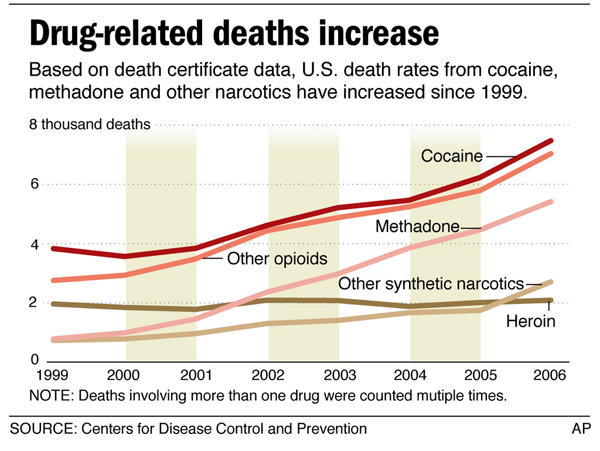
What works
A simple line graph shows that more people are dying from methadone than heroin and the difference is growing over time. It also shows that cocaine is more dangerous than anything other drugs on the graph, at least when it comes to fatalities. Note that these data represent deaths due to acute overdoses as well as fatalities due to complications from long term use.
What needs work
I have no idea what the bars behind the line graphs represent. They seem to be there just to be graphic – I am not in favor of the use of meaningless graphic dross. The article that accompanied this graph mentions that 39,000 people die every year due to drugs and 45,000 die in traffic accidents (though auto-deaths are dropping and were at ~37,000 in 2008 according to Fatality Analysis Reporting System). This means that in some states – mostly in New England and the Mid-Atlantic – more people are dying from drugs than cars. This is big in America where traffic fatalities have long been an unfortunate fact of life. Safety standards have been improving so traffic deaths have fallen. I would have liked to see the traffic deaths applied to this graphic. It would have been more meaningful in the context of the article than the random bars behind the lines.
Where are alcohol related deaths?
The labels go from the very specific “Methodone” to the incredibly vague “other synthetic narcotics” and “other opioids”. The article says that the growth in drug-related fatalities is coming from prescription drugs like Oxycontin, Vicodin, and Methadone. OxyContin and Vicodin contain hydrocodone which places them in the “other opioids” category but it seems like it would also place them in the “other synthetic narcotics” category.
There are plenty of people who will not read the whole article. The graphic needs to speak for itself with clarity, complexity, and completeness otherwise it risks oversimplification and obfuscation.
Bonus graph

The Proceedings of the Community Epidemiology Work Group, January 2009 included a presentation by James Cunningham that featured this data about the increase of oxycodone across the US population. I think this graph helps contextualize the oddly stylized line graph that is the central focus of this post. Here you can see that there is simply much more hydrocodone around than there used to be. The original article by the AP attributes this to the recognition of the treatment of chronic pain as a new and challenging medical field. In that case, then, it should be no surprise that Arizona is a hotbed for hydrocodone prescriptions because the state’s demographic is over-represented by the elderly who are more likely to need pain management strategies.
Final question
I don’t usually get political, and I’ll probably regret posing this question, but here goes.
Do drug companies bear any responsibility for the fatalities involving prescription drugs? Clearly it is in their financial interest to sell an addictive product – and nobody denies that opioids are addictive. Big tobacco ended up having to pay out millions, but that’s because in the beginning, they denied that their products were so unhealthy that using them was potentially fatal. Opioid producers are not making claims one way or the other on the question of fatality beyond admission that the substances are addictive and should be monitored by doctors. This shifts the blame to doctors, but it is often the case that addicted patients will seek these drugs from all sorts of different doctors making it difficult for any given doctor to know just what the patient was prescribed by some other health care professional. It is important to note that opioids offer meaningful treatment for chronic pain where tobacco products did not play a legitimate roll in mainstream medicine and thus should not be banned or taxed, etc.
This brings us back to the original question: should big pharma take some responsibility for deaths due to use/abuse of the prescription drugs from which they derive profit?
References
Associated Press. (2009, September 30) In 16 states, drug deaths overtake traffic fatalities at cleveland.com
A bigger version of the graphic is here: Drug-related deaths increase
Hydrocodone fast facts from drug-addiction.com
Community Epidemiology Working Group. (2009, January) Epidemiologic Trends in Drug Abuse: Proceedings of the Community Epidemiology Working Group | Highlights and Executive Summary [PDF] US Department of Health and Human Services, National Institutes of Health.

Comments 6
Doug — December 14, 2009
Wait, since those deaths are per 100,000 population - not in absolute deaths - doesn't that mean Arizona is *below* the national average?
marco mauas — December 14, 2009
Why not correlate this graph with graphs indicating economic growth?
Tweets that mention Drug related deaths in the US » Graphic Sociology -- Topsy.com — December 14, 2009
[...] This post was mentioned on Twitter by Pierre Bourdieu and Sigve Indregard, marco mauas. marco mauas said: RT @bourdieu: Drug related deaths in the US http://bit.ly/77u2te [...]
Kim Baker — December 15, 2009
Someone just shared your website with me. This is fantastic! I can't wait to share the site with my students. I also thought I'd follow up on a few of the issues you raise because my students had talked about this data some at the beginning of the semester.
It is worth noting that this graph starts at 1999. But drug use of all kinds dropped off in the mid-1980s (after peaks in the mid-70s and early 80s). Use has stayed low since (see for example http://www.monitoringthefuture.org/pubs/monographs/vol2_2002.pdf). Assuming that use and deaths are related, it seems likely that these upswings (which looks significant in this graph) would look much smaller if we included data from 1-2 decades prior. At the end of the day, these increases are rather small - we're talking about an increase in cocaine related deaths of about 4,000. An important difference, for sure, but not a huge and dramatic upswing.
Also, I checked the original CDC report (http://www.cdc.gov/nchs/data/databriefs/db22.htm#summary) and the drug categories are not mutually exclusive. So, if someone died from with multiple substances (which is somewhat common), the different drugs would be counted as multiple deaths. The CDC report specifically says that "In about one-half of the deaths involving opioid analgesics, more than one type of drug was specified as contributing to the death." So, this data is inflated-- we just don't know how much.
Finally, I checked on alcohol-related deaths. This number was a little harder to track down (I focus on illegal drugs, so I don't have this data quite as handy), but according to a gov website about 85,000 deaths per year are related to alcohol and almost half a million are related to tobacco (http://drugwarfacts.org/cms/?q=node/30). Even if these numbers are on the high side (which is plausible considering the source), I think that this kind of data was likely not included because it would dwarf the statistics that are being emphasized. After all, 7,000 deaths from cocaine or "other opiods" does not seem so striking if it were next to 85,000 (alcohol) or 435,000 (tobacco) deaths.
Alan — March 17, 2010
Do drug overdoses kill more people then car cashes?